Sustainability Management Essay: Enhancing Urban Sustainability
VerifiedAdded on 2023/06/15
|6
|1405
|400
Essay
AI Summary
This essay delves into the debate of whether cities can achieve true sustainability. It discusses arguments for and against, highlighting strategies such as smart growth, renewable energy adoption, and water conservation. The essay also addresses challenges like pollution from construction, transportation, and industrial processes, as well as deforestation and waste management issues. Ultimately, it emphasizes the need for a balanced approach that combines technological innovation, policy changes, and individual responsibility to mitigate environmental impact and promote a more sustainable urban future. This document is available on Desklib, a platform offering a range of study tools for students.
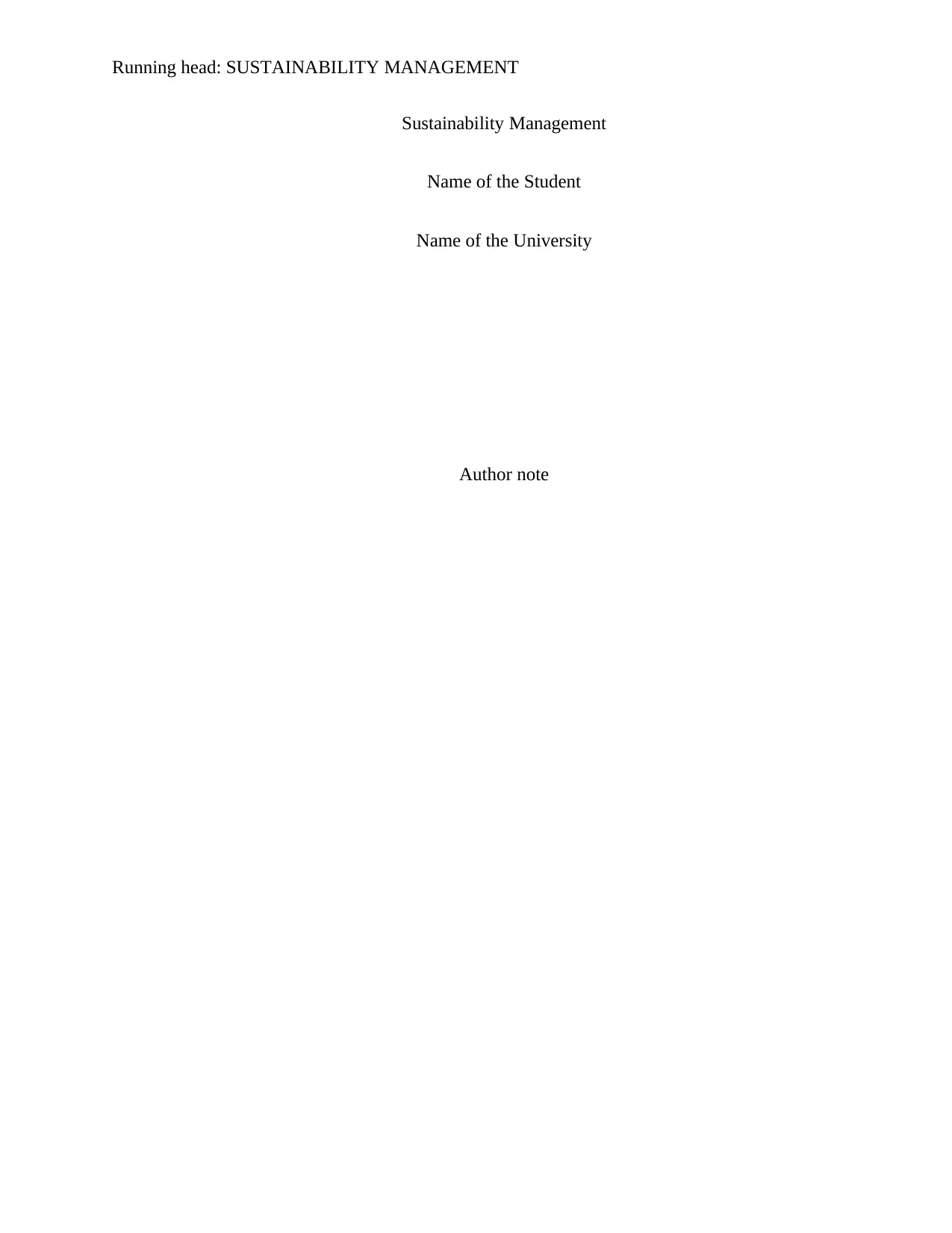
Running head: SUSTAINABILITY MANAGEMENT
Sustainability Management
Name of the Student
Name of the University
Author note
Sustainability Management
Name of the Student
Name of the University
Author note
Paraphrase This Document
Need a fresh take? Get an instant paraphrase of this document with our AI Paraphraser
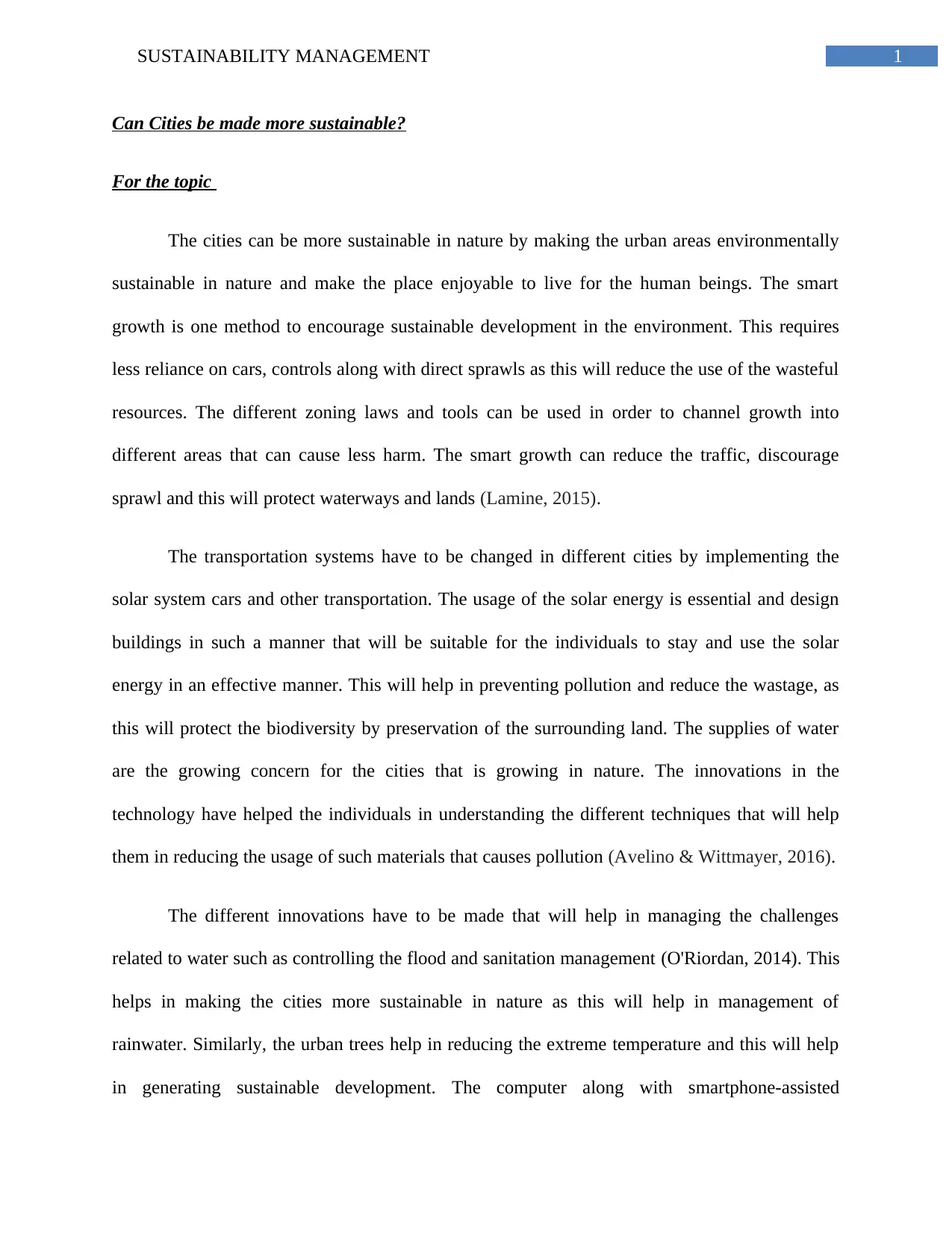
1SUSTAINABILITY MANAGEMENT
Can Cities be made more sustainable?
For the topic
The cities can be more sustainable in nature by making the urban areas environmentally
sustainable in nature and make the place enjoyable to live for the human beings. The smart
growth is one method to encourage sustainable development in the environment. This requires
less reliance on cars, controls along with direct sprawls as this will reduce the use of the wasteful
resources. The different zoning laws and tools can be used in order to channel growth into
different areas that can cause less harm. The smart growth can reduce the traffic, discourage
sprawl and this will protect waterways and lands (Lamine, 2015).
The transportation systems have to be changed in different cities by implementing the
solar system cars and other transportation. The usage of the solar energy is essential and design
buildings in such a manner that will be suitable for the individuals to stay and use the solar
energy in an effective manner. This will help in preventing pollution and reduce the wastage, as
this will protect the biodiversity by preservation of the surrounding land. The supplies of water
are the growing concern for the cities that is growing in nature. The innovations in the
technology have helped the individuals in understanding the different techniques that will help
them in reducing the usage of such materials that causes pollution (Avelino & Wittmayer, 2016).
The different innovations have to be made that will help in managing the challenges
related to water such as controlling the flood and sanitation management (O'Riordan, 2014). This
helps in making the cities more sustainable in nature as this will help in management of
rainwater. Similarly, the urban trees help in reducing the extreme temperature and this will help
in generating sustainable development. The computer along with smartphone-assisted
Can Cities be made more sustainable?
For the topic
The cities can be more sustainable in nature by making the urban areas environmentally
sustainable in nature and make the place enjoyable to live for the human beings. The smart
growth is one method to encourage sustainable development in the environment. This requires
less reliance on cars, controls along with direct sprawls as this will reduce the use of the wasteful
resources. The different zoning laws and tools can be used in order to channel growth into
different areas that can cause less harm. The smart growth can reduce the traffic, discourage
sprawl and this will protect waterways and lands (Lamine, 2015).
The transportation systems have to be changed in different cities by implementing the
solar system cars and other transportation. The usage of the solar energy is essential and design
buildings in such a manner that will be suitable for the individuals to stay and use the solar
energy in an effective manner. This will help in preventing pollution and reduce the wastage, as
this will protect the biodiversity by preservation of the surrounding land. The supplies of water
are the growing concern for the cities that is growing in nature. The innovations in the
technology have helped the individuals in understanding the different techniques that will help
them in reducing the usage of such materials that causes pollution (Avelino & Wittmayer, 2016).
The different innovations have to be made that will help in managing the challenges
related to water such as controlling the flood and sanitation management (O'Riordan, 2014). This
helps in making the cities more sustainable in nature as this will help in management of
rainwater. Similarly, the urban trees help in reducing the extreme temperature and this will help
in generating sustainable development. The computer along with smartphone-assisted
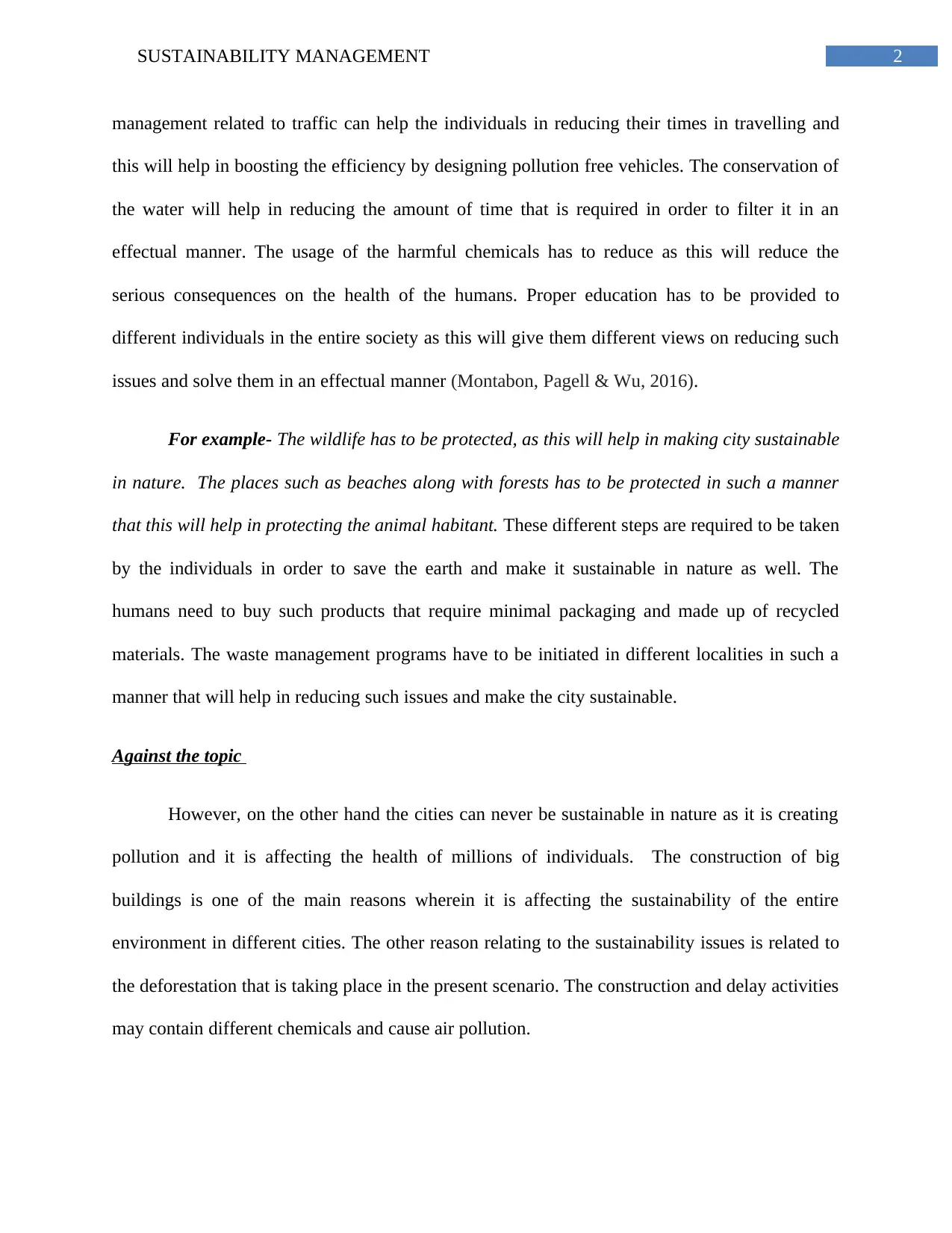
2SUSTAINABILITY MANAGEMENT
management related to traffic can help the individuals in reducing their times in travelling and
this will help in boosting the efficiency by designing pollution free vehicles. The conservation of
the water will help in reducing the amount of time that is required in order to filter it in an
effectual manner. The usage of the harmful chemicals has to reduce as this will reduce the
serious consequences on the health of the humans. Proper education has to be provided to
different individuals in the entire society as this will give them different views on reducing such
issues and solve them in an effectual manner (Montabon, Pagell & Wu, 2016).
For example- The wildlife has to be protected, as this will help in making city sustainable
in nature. The places such as beaches along with forests has to be protected in such a manner
that this will help in protecting the animal habitant. These different steps are required to be taken
by the individuals in order to save the earth and make it sustainable in nature as well. The
humans need to buy such products that require minimal packaging and made up of recycled
materials. The waste management programs have to be initiated in different localities in such a
manner that will help in reducing such issues and make the city sustainable.
Against the topic
However, on the other hand the cities can never be sustainable in nature as it is creating
pollution and it is affecting the health of millions of individuals. The construction of big
buildings is one of the main reasons wherein it is affecting the sustainability of the entire
environment in different cities. The other reason relating to the sustainability issues is related to
the deforestation that is taking place in the present scenario. The construction and delay activities
may contain different chemicals and cause air pollution.
management related to traffic can help the individuals in reducing their times in travelling and
this will help in boosting the efficiency by designing pollution free vehicles. The conservation of
the water will help in reducing the amount of time that is required in order to filter it in an
effectual manner. The usage of the harmful chemicals has to reduce as this will reduce the
serious consequences on the health of the humans. Proper education has to be provided to
different individuals in the entire society as this will give them different views on reducing such
issues and solve them in an effectual manner (Montabon, Pagell & Wu, 2016).
For example- The wildlife has to be protected, as this will help in making city sustainable
in nature. The places such as beaches along with forests has to be protected in such a manner
that this will help in protecting the animal habitant. These different steps are required to be taken
by the individuals in order to save the earth and make it sustainable in nature as well. The
humans need to buy such products that require minimal packaging and made up of recycled
materials. The waste management programs have to be initiated in different localities in such a
manner that will help in reducing such issues and make the city sustainable.
Against the topic
However, on the other hand the cities can never be sustainable in nature as it is creating
pollution and it is affecting the health of millions of individuals. The construction of big
buildings is one of the main reasons wherein it is affecting the sustainability of the entire
environment in different cities. The other reason relating to the sustainability issues is related to
the deforestation that is taking place in the present scenario. The construction and delay activities
may contain different chemicals and cause air pollution.
⊘ This is a preview!⊘
Do you want full access?
Subscribe today to unlock all pages.

Trusted by 1+ million students worldwide
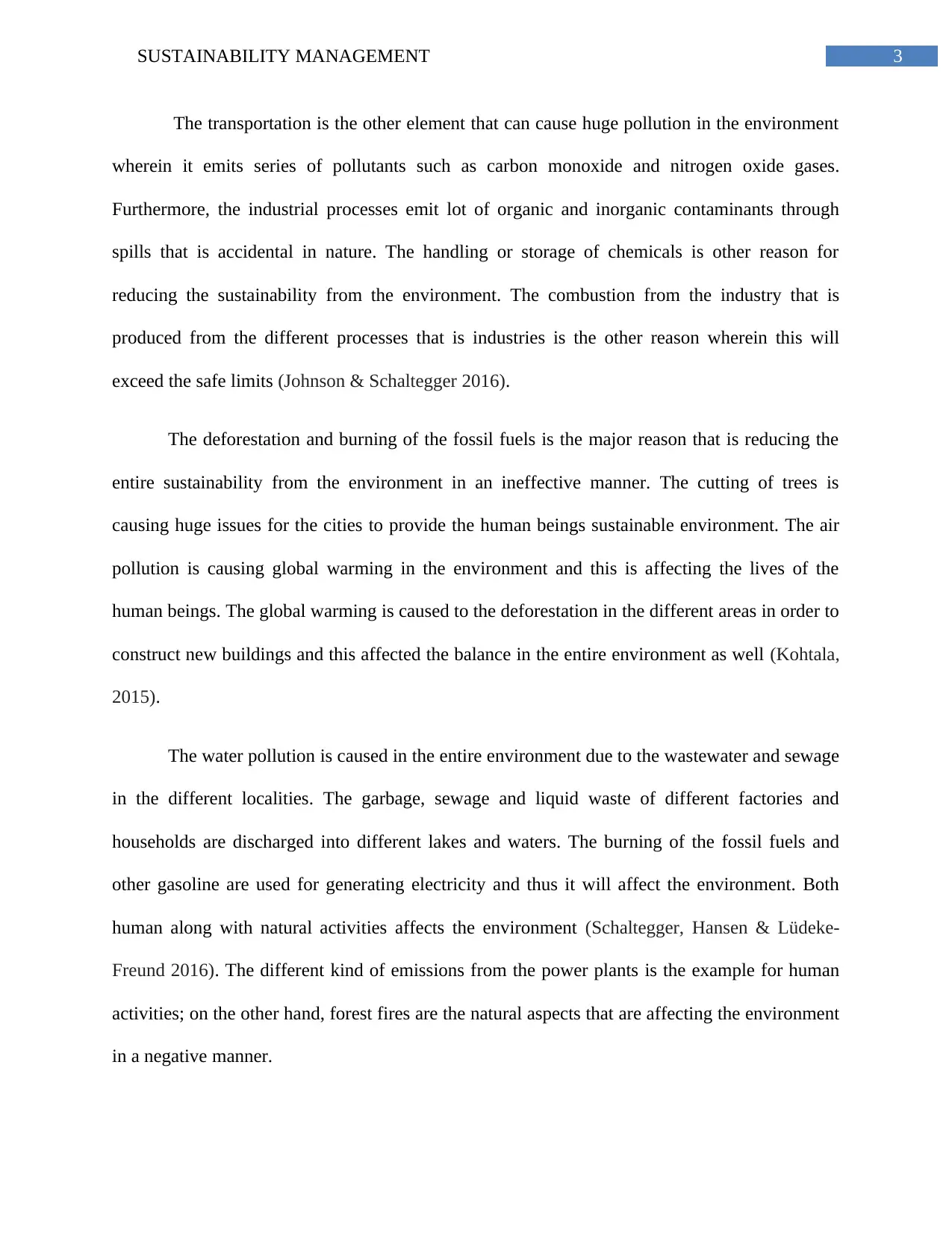
3SUSTAINABILITY MANAGEMENT
The transportation is the other element that can cause huge pollution in the environment
wherein it emits series of pollutants such as carbon monoxide and nitrogen oxide gases.
Furthermore, the industrial processes emit lot of organic and inorganic contaminants through
spills that is accidental in nature. The handling or storage of chemicals is other reason for
reducing the sustainability from the environment. The combustion from the industry that is
produced from the different processes that is industries is the other reason wherein this will
exceed the safe limits (Johnson & Schaltegger 2016).
The deforestation and burning of the fossil fuels is the major reason that is reducing the
entire sustainability from the environment in an ineffective manner. The cutting of trees is
causing huge issues for the cities to provide the human beings sustainable environment. The air
pollution is causing global warming in the environment and this is affecting the lives of the
human beings. The global warming is caused to the deforestation in the different areas in order to
construct new buildings and this affected the balance in the entire environment as well (Kohtala,
2015).
The water pollution is caused in the entire environment due to the wastewater and sewage
in the different localities. The garbage, sewage and liquid waste of different factories and
households are discharged into different lakes and waters. The burning of the fossil fuels and
other gasoline are used for generating electricity and thus it will affect the environment. Both
human along with natural activities affects the environment (Schaltegger, Hansen & Lüdeke-
Freund 2016). The different kind of emissions from the power plants is the example for human
activities; on the other hand, forest fires are the natural aspects that are affecting the environment
in a negative manner.
The transportation is the other element that can cause huge pollution in the environment
wherein it emits series of pollutants such as carbon monoxide and nitrogen oxide gases.
Furthermore, the industrial processes emit lot of organic and inorganic contaminants through
spills that is accidental in nature. The handling or storage of chemicals is other reason for
reducing the sustainability from the environment. The combustion from the industry that is
produced from the different processes that is industries is the other reason wherein this will
exceed the safe limits (Johnson & Schaltegger 2016).
The deforestation and burning of the fossil fuels is the major reason that is reducing the
entire sustainability from the environment in an ineffective manner. The cutting of trees is
causing huge issues for the cities to provide the human beings sustainable environment. The air
pollution is causing global warming in the environment and this is affecting the lives of the
human beings. The global warming is caused to the deforestation in the different areas in order to
construct new buildings and this affected the balance in the entire environment as well (Kohtala,
2015).
The water pollution is caused in the entire environment due to the wastewater and sewage
in the different localities. The garbage, sewage and liquid waste of different factories and
households are discharged into different lakes and waters. The burning of the fossil fuels and
other gasoline are used for generating electricity and thus it will affect the environment. Both
human along with natural activities affects the environment (Schaltegger, Hansen & Lüdeke-
Freund 2016). The different kind of emissions from the power plants is the example for human
activities; on the other hand, forest fires are the natural aspects that are affecting the environment
in a negative manner.
Paraphrase This Document
Need a fresh take? Get an instant paraphrase of this document with our AI Paraphraser
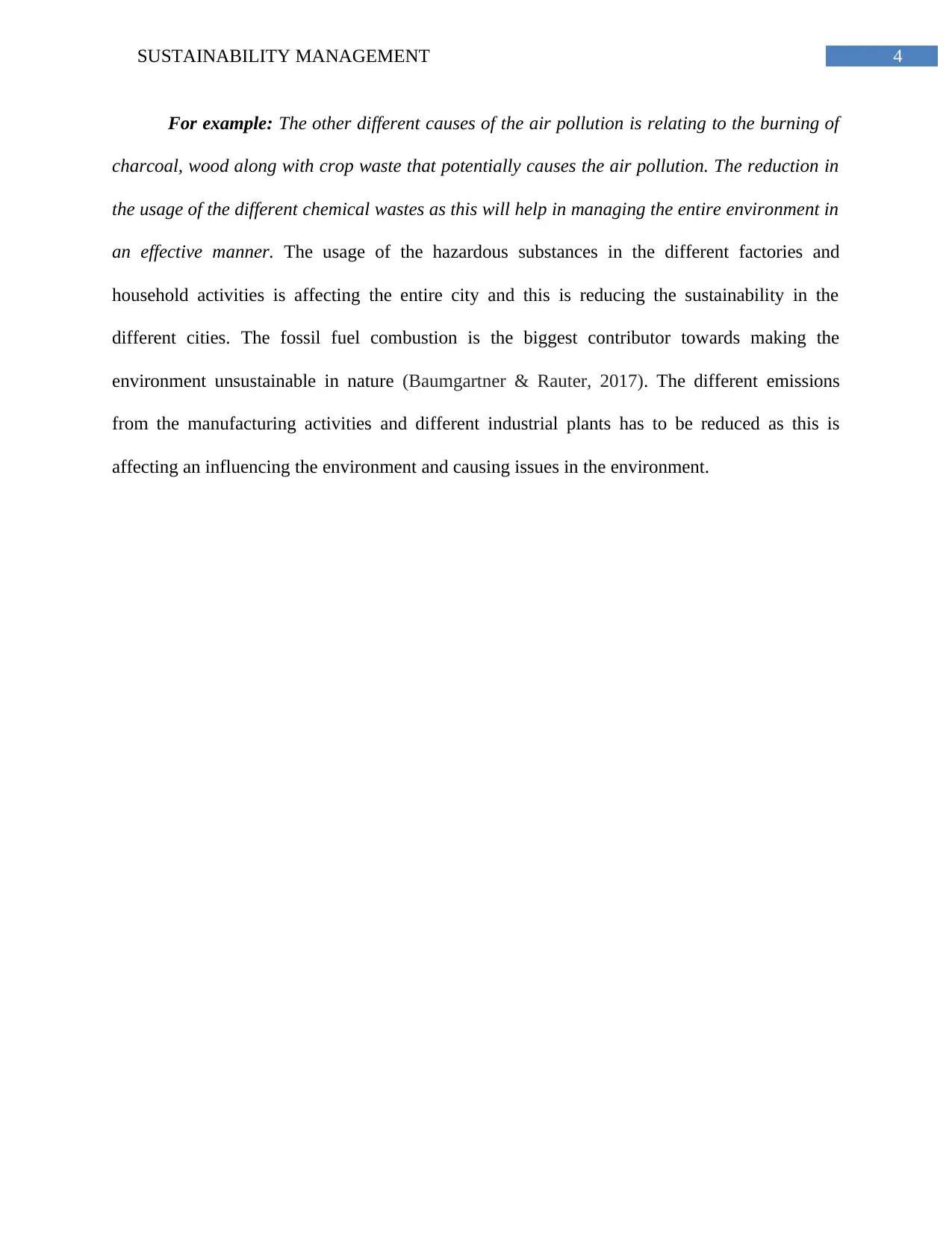
4SUSTAINABILITY MANAGEMENT
For example: The other different causes of the air pollution is relating to the burning of
charcoal, wood along with crop waste that potentially causes the air pollution. The reduction in
the usage of the different chemical wastes as this will help in managing the entire environment in
an effective manner. The usage of the hazardous substances in the different factories and
household activities is affecting the entire city and this is reducing the sustainability in the
different cities. The fossil fuel combustion is the biggest contributor towards making the
environment unsustainable in nature (Baumgartner & Rauter, 2017). The different emissions
from the manufacturing activities and different industrial plants has to be reduced as this is
affecting an influencing the environment and causing issues in the environment.
For example: The other different causes of the air pollution is relating to the burning of
charcoal, wood along with crop waste that potentially causes the air pollution. The reduction in
the usage of the different chemical wastes as this will help in managing the entire environment in
an effective manner. The usage of the hazardous substances in the different factories and
household activities is affecting the entire city and this is reducing the sustainability in the
different cities. The fossil fuel combustion is the biggest contributor towards making the
environment unsustainable in nature (Baumgartner & Rauter, 2017). The different emissions
from the manufacturing activities and different industrial plants has to be reduced as this is
affecting an influencing the environment and causing issues in the environment.
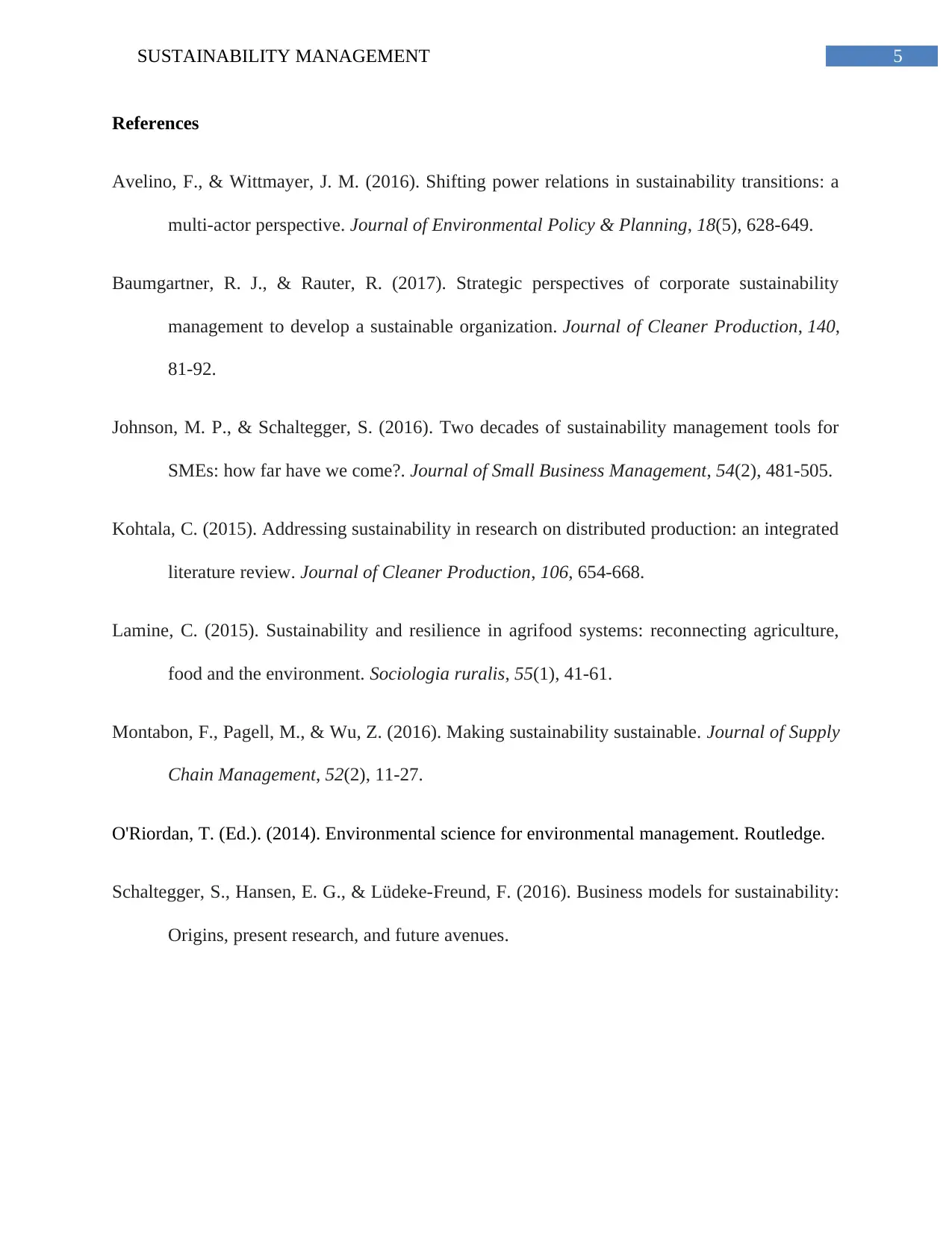
5SUSTAINABILITY MANAGEMENT
References
Avelino, F., & Wittmayer, J. M. (2016). Shifting power relations in sustainability transitions: a
multi-actor perspective. Journal of Environmental Policy & Planning, 18(5), 628-649.
Baumgartner, R. J., & Rauter, R. (2017). Strategic perspectives of corporate sustainability
management to develop a sustainable organization. Journal of Cleaner Production, 140,
81-92.
Johnson, M. P., & Schaltegger, S. (2016). Two decades of sustainability management tools for
SMEs: how far have we come?. Journal of Small Business Management, 54(2), 481-505.
Kohtala, C. (2015). Addressing sustainability in research on distributed production: an integrated
literature review. Journal of Cleaner Production, 106, 654-668.
Lamine, C. (2015). Sustainability and resilience in agrifood systems: reconnecting agriculture,
food and the environment. Sociologia ruralis, 55(1), 41-61.
Montabon, F., Pagell, M., & Wu, Z. (2016). Making sustainability sustainable. Journal of Supply
Chain Management, 52(2), 11-27.
O'Riordan, T. (Ed.). (2014). Environmental science for environmental management. Routledge.
Schaltegger, S., Hansen, E. G., & Lüdeke-Freund, F. (2016). Business models for sustainability:
Origins, present research, and future avenues.
References
Avelino, F., & Wittmayer, J. M. (2016). Shifting power relations in sustainability transitions: a
multi-actor perspective. Journal of Environmental Policy & Planning, 18(5), 628-649.
Baumgartner, R. J., & Rauter, R. (2017). Strategic perspectives of corporate sustainability
management to develop a sustainable organization. Journal of Cleaner Production, 140,
81-92.
Johnson, M. P., & Schaltegger, S. (2016). Two decades of sustainability management tools for
SMEs: how far have we come?. Journal of Small Business Management, 54(2), 481-505.
Kohtala, C. (2015). Addressing sustainability in research on distributed production: an integrated
literature review. Journal of Cleaner Production, 106, 654-668.
Lamine, C. (2015). Sustainability and resilience in agrifood systems: reconnecting agriculture,
food and the environment. Sociologia ruralis, 55(1), 41-61.
Montabon, F., Pagell, M., & Wu, Z. (2016). Making sustainability sustainable. Journal of Supply
Chain Management, 52(2), 11-27.
O'Riordan, T. (Ed.). (2014). Environmental science for environmental management. Routledge.
Schaltegger, S., Hansen, E. G., & Lüdeke-Freund, F. (2016). Business models for sustainability:
Origins, present research, and future avenues.
⊘ This is a preview!⊘
Do you want full access?
Subscribe today to unlock all pages.

Trusted by 1+ million students worldwide
1 out of 6
Related Documents
Your All-in-One AI-Powered Toolkit for Academic Success.
+13062052269
info@desklib.com
Available 24*7 on WhatsApp / Email
![[object Object]](/_next/static/media/star-bottom.7253800d.svg)
Unlock your academic potential
Copyright © 2020–2025 A2Z Services. All Rights Reserved. Developed and managed by ZUCOL.




